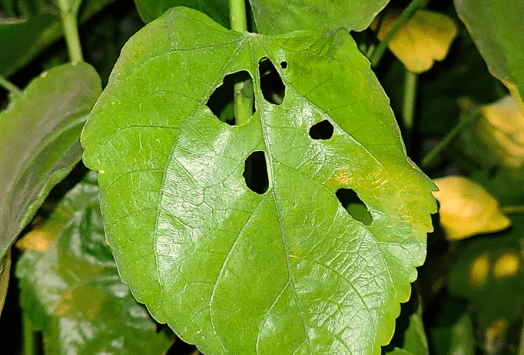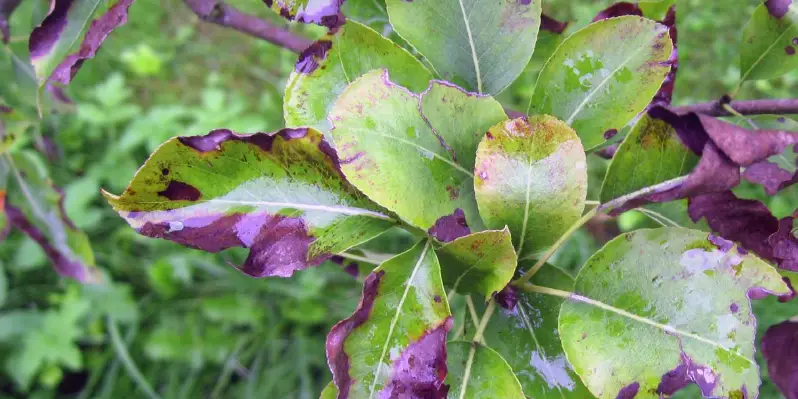If you’ve been growing Hibiscus plants and have noticed that some of the leaves have holes in them, don’t worry, you’re not alone. This is a common problem with Hibiscus plants, but it’s one that can be easily fixed. In this blog post, we will discuss the causes of holes in Hibiscus leaves and how to solve the problem.
Why Are There Holes in My Hibiscus Leaves?
The most likely reason for holes in hibiscus leaves is insect damage. There are a number of different insects that can cause this type of damage, including aphids, caterpillars, beetles, hibiscus sawflies, and earwigs.
These pests enjoy feeding on the leaves of hibiscus plants, and they can cause a lot of damage in a short amount of time. The shape of the holes varies depending on the type of insect, but they are usually circular or oval-shaped.
Look for any pests that may be crawling on the leaves nearby. Be sure to look closely, as the pests can hide in small crevices. If you find any pests, you’ll need to get rid of them before they cause further damage.
How to Treat Hibiscus Leaves with Holes?
To treat hibiscus leaves with holes, you’ll first need to remove any pests that are present. You can do this by hand or with a pesticide. Big bugs, like caterpillars, can be removed by hand. For smaller pests, like aphids and earwigs, you’ll need to use a pesticide.
My favorite method of pest control is to use neem oil (Amazon link), which is an organic, natural pesticide. Gardeners around the world have been using neem oil for centuries to control pests.
Simply mix the neem oil with water according to the instructions on the bottle, and then spray it on your hibiscus plants. Be sure to get both the tops and bottoms of the leaves. The neem oil will kill any pests that are present and will also repel future pests.

How to Keep Pests Away From Hibiscus Leaves?
Prevention is better than the cure, so it’s always a good idea to take steps to prevent pests from attacking your hibiscus plants in the first place. Here are some tips:
- Keep your hibiscus plants healthy and well-watered. A healthy plant is less likely to be attacked by pests
- Remove any dead or dying leaves from your hibiscus plants. These leaves are more likely to be attacked by pests
- If you see any pests on your hibiscus plants, remove them immediately
- Plant your hibiscus plants in an area that is well-ventilated and has good air circulation
- Encourage beneficial insects, like ladybugs and lacewings, to live in your garden. These insects will help to control pests
- Use row covers to protect your hibiscus plants
By following these tips, you can help to prevent holes from forming in your hibiscus leaves.
What Else Causes Holes in Hibiscus Leaves?
There are a couple of other reasons why hibiscus leaves may have holes in them:
Disease
One possibility is that the plant is suffering from a disease, like anthracnose or rust. These diseases can cause the leaves to develop brown or yellow spots, which can eventually turn into holes.
If you suspect that your hibiscus plant has a disease, it’s a good idea to use fungicide to treat the plant. Again, neem oil is a good option, as it’s an organic, natural fungicide.
Wind Damage
Another possibility is that the holes have been caused by wind damage. Hibiscus plants are native to tropical regions and are not used to cold or windy conditions. If your hibiscus plant is exposed to too much wind, the leaves can develop holes.
To prevent wind damage, you should plant your hibiscus plant in an area that is sheltered from the wind. You can also use mulch to help protect the roots of the plant from the cold.
Animals
Lastly, animals can also cause holes in hibiscus leaves. Squirrels, birds, and rabbits all enjoy nibbling on hibiscus leaves. If you suspect that an animal is eating your hibiscus leaves, you’ll need to take steps to deter them.
One way to do this is to make a physical barrier, like a fence, around the plant. You can also try using a repellent, like cayenne pepper or chili powder. Simply sprinkle the repellent around the base of the plant.
Should I Prune Hibiscus Leaves with Holes?
There’s usually no need to prune hibiscus leaves with holes unless the leaves are so damaged that they’re affecting the plant’s overall health. If this is the case, you can trim off the affected leaves.
It’s also a good idea to remove any leaves that are seriously affected by a fungal disease. These leaves should be removed and destroyed to prevent the disease from spreading.
When pruning, be sure to sterilize your pruning shears with rubbing alcohol or bleach to prevent the spread of disease.
Conclusion
In conclusion, holes in hibiscus leaves can be caused by pests, disease, wind damage, or animals. The best way to prevent holes from forming is to take steps to protect your hibiscus plants from these threats. If holes do form, they can usually be fixed by using a pesticide or fungicide, like neem oil.
I hope this article was helpful in solving the mystery of the holes in your hibiscus leaves! Thanks for reading.
Tim is an avid gardener from the UK. He was the founder of PlantCarer.com from 2021 to Sep 2023. He sold PlantCarer.com to Aaron. He has since started his own business called Seed To Supper, which provides new gardeners all the materials you need in a box (pots, seeds, compost and instructions) to grow your own delicious and nutritious vegetables and herbs from start to finish – no garden required.











0 Comments